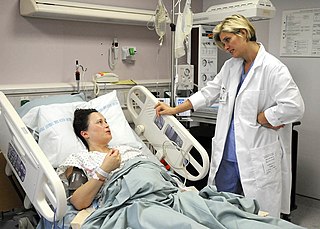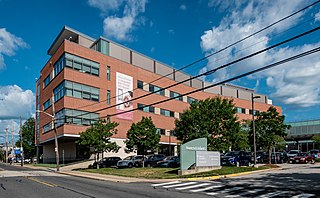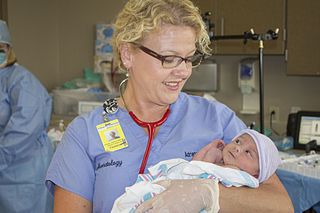
Midwifery is the health science and health profession that deals with pregnancy, childbirth, and the postpartum period, in addition to the sexual and reproductive health of women throughout their lives. In many countries, midwifery is a medical profession. A professional in midwifery is known as a midwife.

Childbirth, also known as labour, parturition and delivery, is the completion of pregnancy where one or more babies exits the internal environment of the mother via vaginal delivery or caesarean section. In 2019, there were about 140.11 million human births globally. In the developed countries, most deliveries occur in hospitals, while in the developing countries most are home births.

A doula is a trained professional who provides expert guidance for the service of others and who supports another person through a significant health-related experience, such as childbirth, miscarriage, induced abortion or stillbirth, as well as non-reproductive experiences such as dying. A doula might also provide support to the client's partner, family, and friends.

A home birth is a birth that takes place in a residence rather than in a hospital or a birthing center. They may be attended by a midwife, or lay attendant with experience in managing home births. Home birth was, until the advent of modern medicine, the de facto method of delivery. The term was coined in the middle of the 19th century as births began to take place in hospitals.

Kangaroo mother care (KMC), which involves skin-to-skin contact (SSC), is an intervention to care for premature or low birth weight (LBW) infants. The technique and intervention is the recommended evidence-based care for LBW infants by the World Health Organization (WHO) since 2003.

A neonatal intensive care unit (NICU), also known as an intensive care nursery (ICN), is an intensive care unit (ICU) specializing in the care of ill or premature newborn infants. The NICU is divided into several areas, including a critical care area for babies who require close monitoring and intervention, an intermediate care area for infants who are stable but still require specialized care, and a step down unit where babies who are ready to leave the hospital can receive additional care before being discharged.

In the United States, a Certified Nurse-Midwife (CNM) is a nurse midwife who exceeds the International Confederation of Midwives' essential competencies for a midwife and is also an advanced practice registered nurse, having completed registered nursing and midwifery education leading to practice as a nurse midwife and credentialing as a Certified Nurse-Midwife. CNMs provide care of women across their lifespan, including pregnancy and the postpartum period, and well woman care and birth control. Certified Nurse-Midwives are recognized by the International Confederation of Midwives as a type of midwife in the U.S.

Neonatal nursing is a sub-specialty of nursing care for newborn infants up to 28 days after birth. The term neonatal comes from neo, "new", and natal, "pertaining to birth or origin". Neonatal nursing requires a high degree of skill, dedication and emotional strength as they care for newborn infants with a range of problems. These problems vary between prematurity, birth defects, infection, cardiac malformations and surgical issues. Neonatal nurses are a vital part of the neonatal care team and are required to know basic newborn resuscitation, be able to control the newborn's temperature and know how to initiate cardiopulmonary and pulse oximetry monitoring. Most neonatal nurses care for infants from the time of birth until they are discharged from the hospital.

Women & Infants Hospital of Rhode Island is a women and infants' hospital in Providence, Rhode Island. It is the primary teaching hospital in obstetrics, gynecology, and newborn pediatrics of the Warren Alpert Medical School at Brown University. In 1996, Women & Infants Hospital was a founding member of the Care New England Health System.
Amy Spangler is a breastfeeding expert and president of baby gooroo who has lectured extensively and published several books on breastfeeding. In addition to earning a bachelor's and master's degree in nursing, Spangler is a registered nurse and an internationally board certified lactation consultant, and she has held leadership positions with national and international organizations including President of the International Lactation Consultant Association. She has also served as an expert contributor to Breastfeeding.com and as a member of their professional advisory board.
The Canadian Perinatal Network (CPN) is made up of Canadian researchers who collaborate on research issues relating to perinatal care. The network commenced in September 2005, and includes members from 25 tertiary perinatal units. CPN will enable health care professionals, researchers, and administrators to participate actively in clinical, epidemiologic, health services, health policy, and informatics research aimed at improving the effectiveness and efficiency of perinatal care.
Early postnatal hospital discharge generally refers to the postpartum hospital discharge of the mother and newborn within 48 hours. The duration of what is considered "early discharge" varies between countries from 12 to 72 hours due to the differences in average duration of hospital stay. The World Health Organisation (WHO) recommends healthy mothers and newborns following an uncomplicated vaginal delivery at a health facility to stay and receive care at the facility for at least 24 hours after delivery. This recommendation is based on findings which suggest that the first 24 hours after giving birth poses the greatest risks for both the mother and newborn.
Ruth Watson Lubic, CNM, EdD, FAAN, FACNM, is an American nurse-midwife and applied anthropologist who pioneered the role of nurse-midwives as primary care providers for women, particularly in maternity care. Lubic is considered to be one of the leaders of the nurse-midwifery movement in the United States.

The Journal of Obstetric, Gynecologic, & Neonatal Nursing is a peer-reviewed nursing journal in the fields of obstetrical nursing, women's health nursing, and neonatal nursing. It is the official publication of the Association of Women's Health, Obstetric and Neonatal Nurses.
Obstetrical nursing, also called perinatal nursing, is a nursing specialty that works with patients who are attempting to become pregnant, are currently pregnant, or have recently delivered. Obstetrical nurses help provide prenatal care and testing, care of patients experiencing pregnancy complications, care during labor and delivery, and care of patients following delivery. Obstetrical nurses work closely with obstetricians, midwives, and nurse practitioners. They also provide supervision of patient care technicians and surgical technologists.

A neonatal nurse practitioner (NNP) is an advanced practice registered nurse (APRN) with at least 2 years experience as a bedside registered nurse in a Level III NICU, who is prepared to practice across the continuum, providing primary, acute, chronic, and critical care to neonates, infants, and toddlers through age 2. Primarily working in neonatal intensive care unit (NICU) settings, NNPs select and perform clinically indicated advanced diagnostic and therapeutic invasive procedures. In the United States, a board certified neonatal nurse practitioner (NNP-BC) is an APRN who has acquired Graduate education at the master's or doctoral level and has a board certification in neonatology. The National Association of Neonatal Nurse Practitioners (NANNP) is the national association that represents neonatal nurse practitioners in the United States. Certification is governed by the National Certification Corporation for Obstetrics, Gynecologic and Neonatal Nursing Specialties (NCC).
Evelyn Lundeen was an American nurse who headed the first premature nursery in the United States with Dr. Julius Hess. Outside of her work at the nursery, Lundeen traveled to other cities to teach the principles of nursing care for premature infants. With Hess, she also co-authored an early textbook on premature baby care.
Adejoke Bolanle Ayoola is a Nigerian-American academic and nursing researcher at Calvin University.

A nurse midwife is both a nurse and a midwife, having completed nursing and midwifery education leading to practice as a nurse midwife and sometimes credentialed in the specialty. Nurse midwives provide care of women across the lifespan, including during pregnancy and the postpartum period, and well woman care and birth control.










